Baby Jumper Age Ranges: The Right Ages to Start & Stop
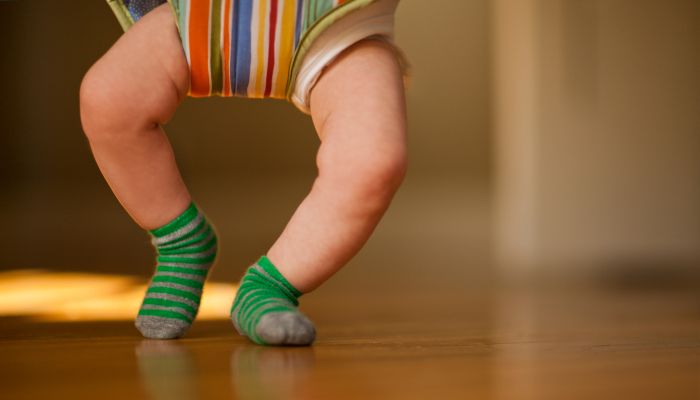
- Parents love baby jumpers because they give your baby a safe space to play while giving you a break.
- Babies in the pre-walking stage with good head control can use baby jumpers.
- It’s important to always supervise your child when using a jumper or bouncer to keep them safe.
Many parents swear by baby jumpers, bouncers, and activity centers as a way to keep their baby safe, happy, and stimulated. Jumpers give parents and caregivers a safe place to put the baby for a few minutes while they take a much-needed break or get other things done.
But as with all baby equipment and toys, it’s important to use baby jumpers properly to prevent accidents and injuries. Consider your baby’s age, weight, and signs of readiness before investing in a baby jumper.
How Does a Baby Jumper Work?
A baby jumper—also known as a baby bouncer, jumper seat, door bouncer, or stationary jumper—is a piece of baby gear that many moms will say is essential. They come in many different styles, so it’s worth researching the best baby jumpers to find one that’s right for your baby and your home.
Stationary jumpers, such as the Jumperoo, have a seat for your baby that allows them to jump by pushing off the floor. The seat is surrounded by a frame that has toys and buttons attached to keep your baby entertained while they jump and bounce.
Other baby jumpers have a seat attached to a sling that can be hung from a door frame or a ceiling beam. Some of these may also have toys attached.
Once you put your baby in a baby jumper, you’ll be amazed by how quickly your baby’s legs will move as they start jumping and get the hang of bouncing.
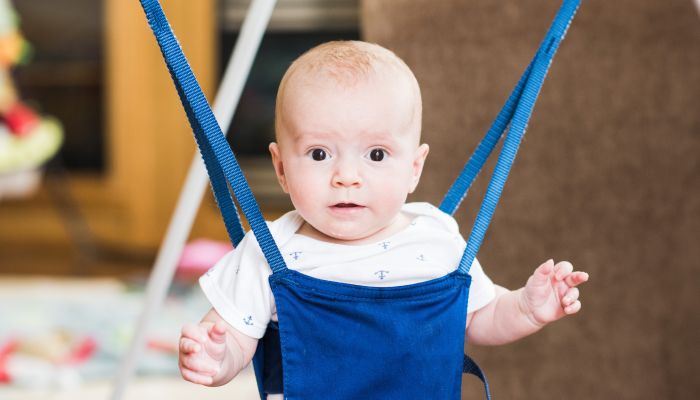
What Age Can Babies Start Using Jumpers?
There is no specific “right age” at which a baby can start to use a jumper. Instead, you should consider your baby’s size, weight, head control, and signs that they are physically ready.
Experts suggest that a baby can start using a jumper once they have strong, independent head control. Baby jumpers work best for babies who have started to crawl but are not yet walking.
You should also consider your baby’s reaction to the jumper. Some babies may love jumping, but others may find it overstimulating or uncomfortable.
What Age and Weight Should a Baby Stop Using a Jumper?
Always follow the manufacturer’s label for age and weight restrictions on baby equipment. Most jumpers have a weight limit of 25 to 30 pounds. Additionally, once a baby can pull up to standing using furniture or they can walk, they should no longer use the jumper as they may attempt to pull themselves out of it.
Your baby’s age and weight are important to consider when deciding to stop using a jumper. But you should also pay attention to physical signs that they have outgrown it. This is why it’s important to never leave a baby unattended in a baby jumper.
How Long Can a Baby Stay in a Jumper?
While most babies love jumping and may seem content in a baby bouncer, parents should limit the amount of time their baby uses this favorite toy.
Babies should not spend more than 10 to 15 minutes in a baby jumper at a time and no more than twice a day. The American Academy of Pediatrics cautions against babies spending too much time in any kind of baby equipment—including car seats, jumpers, strollers, swings. Too much time in these devices can lead to delays in motor skill and muscle development.
Additionally, according to the UK’s National Health Service, spending too much time in a jumper that doesn’t allow your child’s feet to touch the floor can lead to delays in walking or walking on tiptoes.
It’s also important that baby bouncer time doesn’t replace tummy time on the floor. It may seem like your little one is getting a lot of exercise in the baby jumper, particularly if they are very active in it. But daily tummy time is more important for your baby’s muscle development.
What Are the Benefits of Using a Jumper?
When used properly, your baby may find the jumper a stimulating place to sit and play. Plus, jumpers give you a few moments with your hands-free to do other things that need doing.
Although it might look like your baby is getting a lot of exercise in their jumper, there is no evidence that they improve motor function or lead to early walkers. Instead, consider baby jumpers as a way to entertain your baby when you need a few minutes to unload the dishwasher or get dinner on the table.
A baby bouncer or door frame jumper can be especially helpful if your child has special needs. For children with sensory impairments, a jumper can provide fun and entertainment as well as vestibular stimulation, which is the body’s sense of its location in space.
Merry Muscles is a jumper that comes in larger sizes for children with special needs. Your child can still benefit from the stimulation and muscle development that a jumper provides in a size more appropriate and comfortable for them.
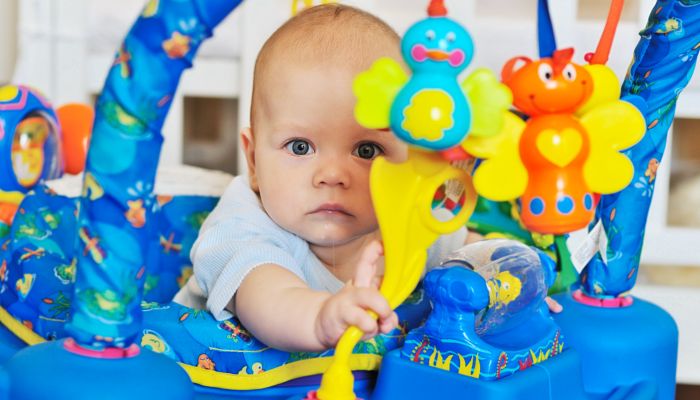
What Are Baby Jumper Safety Considerations?
A baby jumper may be fun for your little one and make your life a little easier. But leaving your baby in the jumper for long periods can lead to injuries such as hip dysplasia because of the position of the seat in most jumpers.
According to the Children’s Hospital of Los Angeles, parents should think about these safety tips whenever buying baby gear like baby bouncers or seats: First, make sure the item doesn’t put too much pressure on your baby’s spine. And second, the seat should keep your baby’s hips in a natural and relaxed position.
When deciding whether to use a jumper, you should also think about the space where your baby is going to play. Although they take up more room, the best baby jumpers are stationary jumpers because they lead to fewer falls and accidents than door frame jumpers.
Because door frame jumpers can swing from side to side, a vigorous bounce from your baby can lead to knocking their head on the door frame or pinching fingers or toes. The best baby jumper is one that stays put so your baby can’t swing into anything accidentally.
If you choose to use a baby jumper, be wary of accepting hand-me-downs from family or purchasing second-hand. Many baby products, including baby jumpers, have been recalled in recent years due to safety issues. It’s safest to buy a new product, register the product, and monitor for any recalls.
Additionally, avoid baby walkers. Babies have been known to flip these over or fall down a flight of stairs, causing serious injury. Instead, choose a stationary baby jumper or a toy that babies can push while they cruise.
It’s also important to only use baby jumpers on the floor and on a flat surface – never on a tabletop or counter.
What Are Some Alternatives to Baby Jumpers?
There are many products on the market for young babies in addition to baby jumpers, like walkers and activity centers. But do your research to make sure that any baby gear you buy adheres to the proper safety standards.
Toys like baby walkers may look like fun for babies, but experts suggest that they also put them at risk of accidents and injuries. Instead, consider a stationary baby activity center that does not bounce or move but that supports your baby while they stand.
It’s important to also remember that you don’t need fancy toys or devices to keep your baby happy and stimulated. The best exercise for babies is still playing on the floor supervised, doing tummy time and using their little muscles naturally.
The information WonderBaby provides is not intended to be, and does not constitute, medical or other health advice or diagnosis and should not be used as such. Always consult with a qualified medical professional about your specific circumstances.
Related Posts
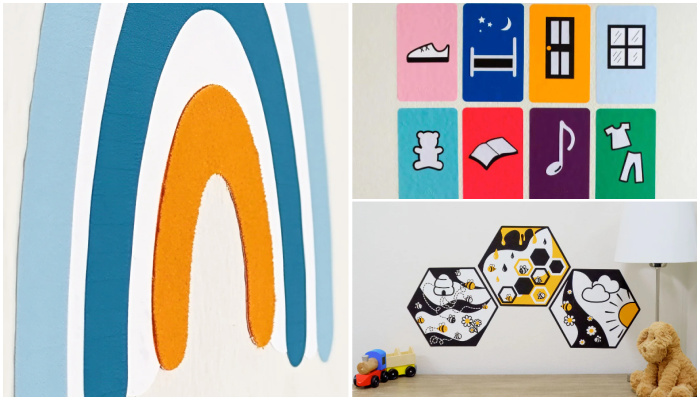
Parenting
Sensory Wall Art: 5 Tips to Create a Room Your Blind or Low-Vision Child Will Love
Even if your child can’t see their surroundings, personalizing and decorating their room with thoughtful, sensory-friendly design can make a big difference in their confidence, independence, and joy.

Development, Special Needs
How to Track Milestones for Developmentally Delayed Babies
Parents of developmentally delayed babies can explore practical tools and strategies to track milestones, celebrate progress, and support their child’s unique developmental journey.
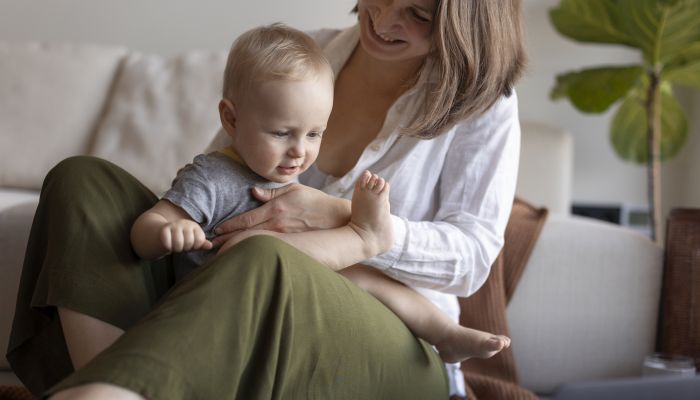
Fine and Gross Motor
5 Alternatives to Tummy Time for Babies with Motor Development Challenges
Does your baby struggle with tummy time due to motor development challenges? These alternatives to tummy time will offer the same benefits.